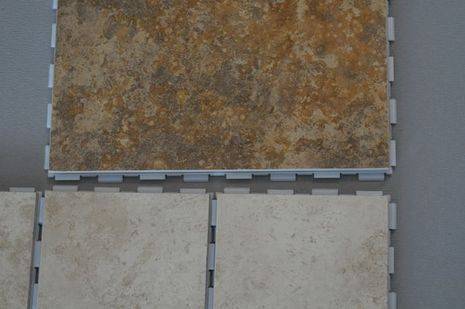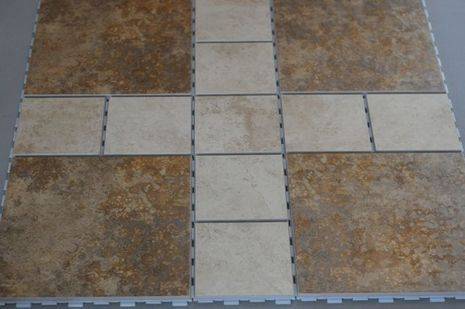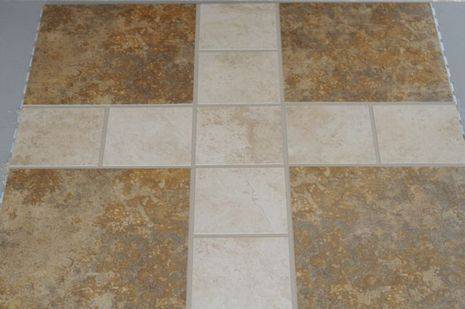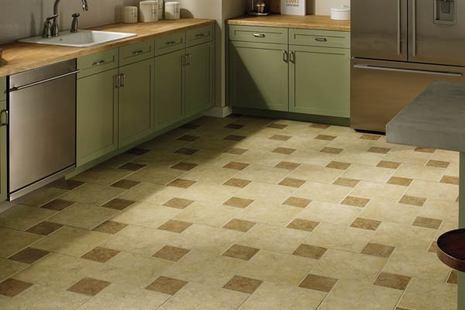Recently I had the opportunity to play with a product called SnapStone. SnapStone is a porcelain floating floor system that can be installed over most vinyl, wood and concrete sub-floors. I’ve seen this product before in my local big box store in the ‘real’ tile aisle and have always looked upon it a bit suspiciously. It couldn’t possibly rival real stone or tile, I thought. So, when the boxes of SnapStone arrived at my front door, I was excited to see how it would compare.
First of all, SnapStone is real porcelain tile. The only difference between it and traditional tile–and it’s a big one–is it has interlocking tabs around its perimeter which allows it to float. This trick allows DIYers to put it over just about any existing structurally sound flooring.

And speaking of DIYing, let’s talk about the installation process. First, there’s no real prep work to the existing flooring itself–except that it should be clean, smooth and dry. You can start laying out tile either in the middle of the room or at a wall. Then you just line up the tabs of tile and push or tap them together using a white-headed rubber mallet. What’s great about the tabs, of course, is your grout lines are always spot on.
You can cut SnapStone like you would traditional porcelain tile (the instructions suggested using a wet saw) but you should avoid cutting pieces that have LESS than 2 tabs left on the uncut sides. Once all the tiles are set, you’re ready to grout.
In a SnapStone installation, you MUST use SnapStone Flexible Grout. It comes in tubs which require no additives. You just have to mix it, like you would paint. I used a traditional tile float to spread the grout and then sponged off using a dry-wet sponge.

I must say, working with the flexi grout was a treat. It was much easier to spread than traditional grout as it kind of stuck together creating less grout ‘crumbs’. Sponging off was easier too. It wasn’t even what I’d consider messy, when compared to sponging off traditional grout.
When my test floor was done, I was…well…floored! It looked great!

If after reading this post you’re all set to buy SnapStone, there’s a few things you need to know. First, after grouting, wait a good 48 to 72 hours to move furniture onto the tile. The grout does set up in about the same time as traditional grout, but it was still pliable after 24 hours. (Felt kind of like a rubber ball.) In 72, it was hard and ready for serious foot traffic. Also, setting SnapStone around the perimeter of a room isn’t quite as easy as setting regular tile. The tabs need to be finessed into place with a rubber-coated pull bar. And finally, removing a broken tile isn’t as easy as a traditional tile either, which you can just smack in the middle with a hammer and lift out. A broken SnapStone tile is removed by working your way to it from the perimeter. Again, that’s because of the interlocking tabs. That being said, a broken tile is probably a rare occurrence.
POST UPDATE: The SnapStone folks forwarded a link to a video showing how to replace one of their tiles.
So there you have it. SnapStone, it’s definitely a formidable contender in flooring alternatives for the DIYer. And, yes, it belongs in the tile aisle!!
For more information about the product, installation process, as well as gallery photos, follow this link to SnapStone.

What about trim. Do I have to use quarter round next my orginal trim to cover the gap and do I just glue it to the tile?
What about trim. Do I have use quarter round next my orginal trim to cover any gap and do I glue it to the floor?
This stuff is JUNK. Installed for less than a week and already have had to replace 3 broken tiles in a 12×15 kitchen!! You couldn’t give me this stuff again for free and it was super expensive. I leveled the floor and screwed down all new 3/4″ subfloor. But to no avail. TILES BREAKING LEFT AND RIGHT. Company says, “Our tiles don’t break for no reason at all” , so basically “Sorry we won’t stand behind our product” That ten year warranty isn’t worth good toilet paper! If they won’t stand behind the product then what good is a warranty?? They push it for the DIYer’s because its easy to install, but guess what if you read the fine print, warranty is only good if its installed by a proffessional certified installer?? When you pay for that installation, it becomes far more expensive than real tile. Save your money and buy the real deal or get something besides tile. The webbing on the back of the tile doesn’t allow the tile to be fully supported therefor it has voids allowing it to flex and break.
There is a reason real tile is set in mortar and fully supported from edge to edge, because it DOESNT and CANT flex. This floating tile system allows the floor to float and flex. Problem is porcelain doesn’t flex, it BREAKS. Can’t say enough bad about this stuff. After spending around $5000 to do a kitchen and a small entry way, it’s really frustrating to have to dig up tile you just laid because its broken and then to have the company basically tell me that their tile doesn’t break it has to be something I did wrong?? Maybe they should do a google search for “Snapstone procelain tile problems or reviews”? I’m not the only one having problems. I’m local to the man that invented this stuff, the first flooring company he took the concept to turned him down and didn’t want to make it. I may have found out why they turned his design down, ITS JUNK, EXPENSIVE, and REPAIRS ARE QUESTIONABLE FIXES AT BEST!!!!!!!!!!!! Basically you use subfloor adhesive to hold the tile in place when you set the replacement tile in. Never been so disgusted with a purchase in all my life. If only one person reads this and decides to buy something else, then I have succeeded with this ten minutes of writing. Customer feedback is very powerful thing. It can help a business and it can ruin a business. Smart business persons know this, hence the motto “customer is always right”. Snapstone has no sense of customer relations and what an angry customer is capable of with todays social media and internet.
All I can say is “DON’T BUY SNAPSTONE!!!!! KEEP WHAT YOU HAVE I’LL GUARANTEE YOU ITS BETTER THAN SNAPSTONE”……. OR
CRAPSTONE, CRACKSTONE WHATEVER YOU WANT TO CALL IT
I CALL IT #&$*ING JUNK!!!!!!!!!!!!!!!!!!